What Do You Call the Way Elements Are Arranged in a Work of Art?
The principles of art (or the principles of design) are essentially a set of criteria which are used to explain how the visual elements are arranged in a work of art. These principles are possibly the closest thing nosotros have to a set of objective criteria for analyzing and judging fine art.
Art is a notoriously grayness area when information technology comes objectively defining what is corking and what is not. An artist of 1 era may be mocked during his lifetime, yet revered after his passing (such as Vincent van Gogh). The principles of fine art help combat this gray area to some extent. They allow usa to communicate what makes a peachy painting great with an element of objectivity and consistency.
The following is an explanation of what the principles of art are and how you lot can apply them to do good your own artworks.
Pattern
Blueprint is a very of import pattern concept which refers to the visual system of elements with a repetitive grade or intelligible sequence.
Pattern is not always obvious. It could be a uncomplicated underlying notan design which dances between lite and night in some kind of sequence. Or it could be the use of similar colour patterns throughout your painting.
In the painting below, find how the top arm of the subject virtually blends into the background, and how the legs alloy into the cloth, and the cloth blends into the residuum of the foreground. This interlinking pattern drags you through the painting and creates a very interesting design.
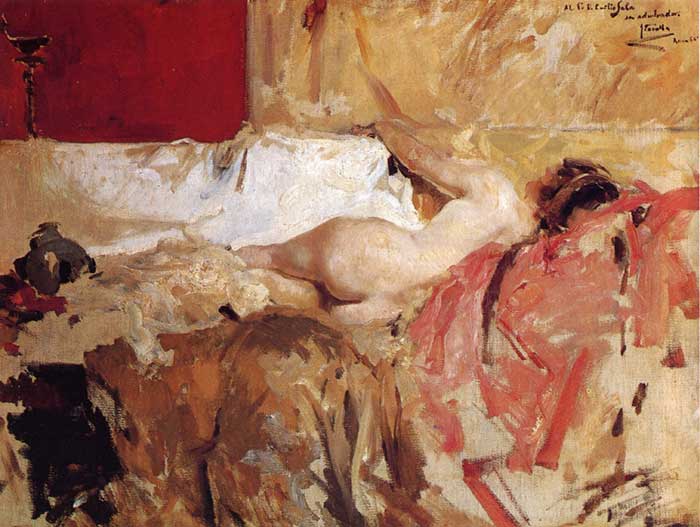
Joaquin Sorolla, Bacchante, 1886
Read more than near pattern in art.
Balance
Balance is concerned with the visual distribution or weight of the elements in a piece of work of art. A painting could exist balanced if one one-half is of the same visual weight as the other one-half. Or, you could have a minor expanse of heightened significance which is balanced confronting a much larger expanse of less significance, like in the painting below. In the painting below, discover how the dark areas used for the gunkhole and foreground appear balanced against the much larger area of soft, tinted colors.

Efim Volkov, Seascape, 1895
Emphasis
Emphasis is a mode of using elements to stress a certain area in an artwork. Emphasis is really just another manner to depict a focal point in your artwork. In the painting beneath, at that place is strong emphasis on the moon through the utilize of color contrast.
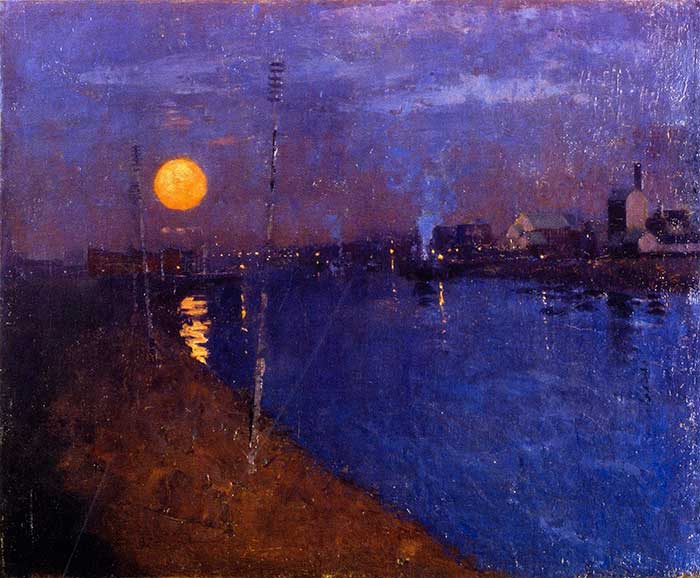
George Henry, River Landscape Past Moonlight, 1887
You can read more about emphasis in art here.
Contrast
Contrast is everything in art. Without it, an artwork would exist cypher just a blank surface. Dissimilarity tin come up in many forms:
Texture dissimilarity: A contrast between smooth and textured. Many of Vincent van Gogh'due south paintings are nifty examples of texture contrast in action.
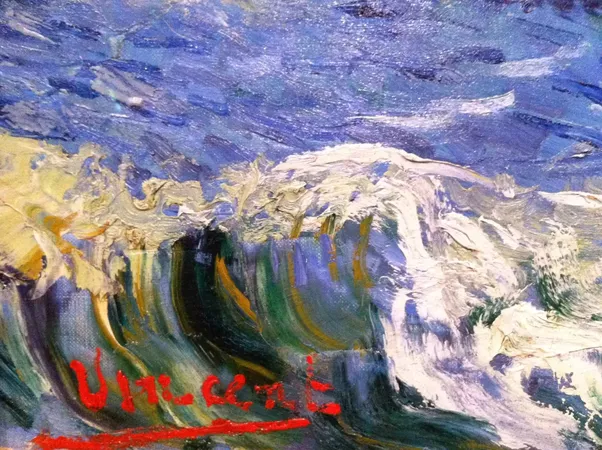
Color contrast: A contrast between calorie-free and nighttime, saturated and slow or complementary colors (hue contrast). For case, in the painting below, the highly saturated red contrasts against the relatively dull colors in the remainder of the painting.
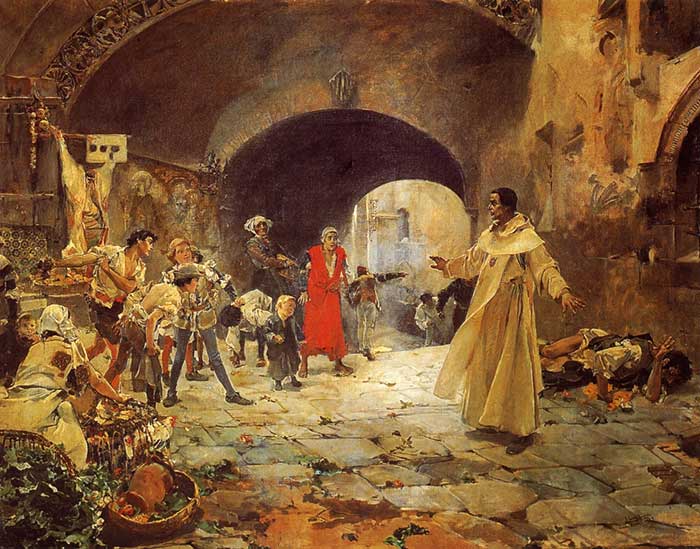
Joaquin Sorolla, Father Jofre Protecting A Madman, 1887
Particular contrast: A contrast betwixt areas of detail and more bland areas, like in the painting beneath.
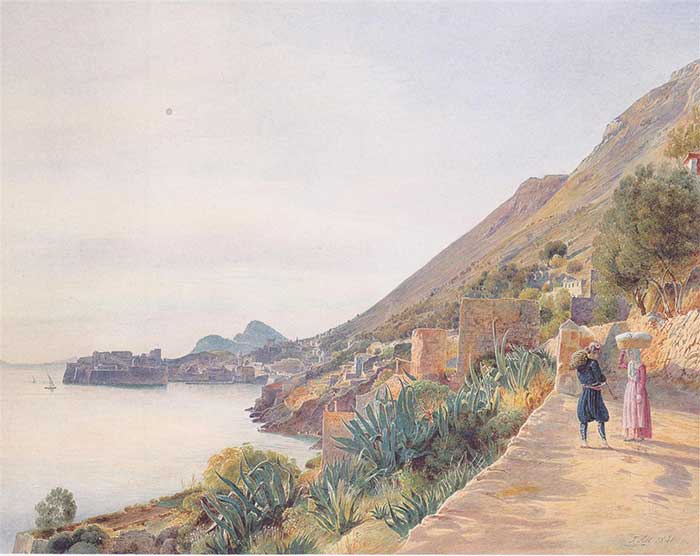
Rudolf von Alt, View Of Ragusa, 1841
Shape contrast: A contrast between different shapes (rectangles and circles). For example, in the painting there are the curving shapes created by the winding paths, water and trees contrast against the rectangular shapes of the buildings.
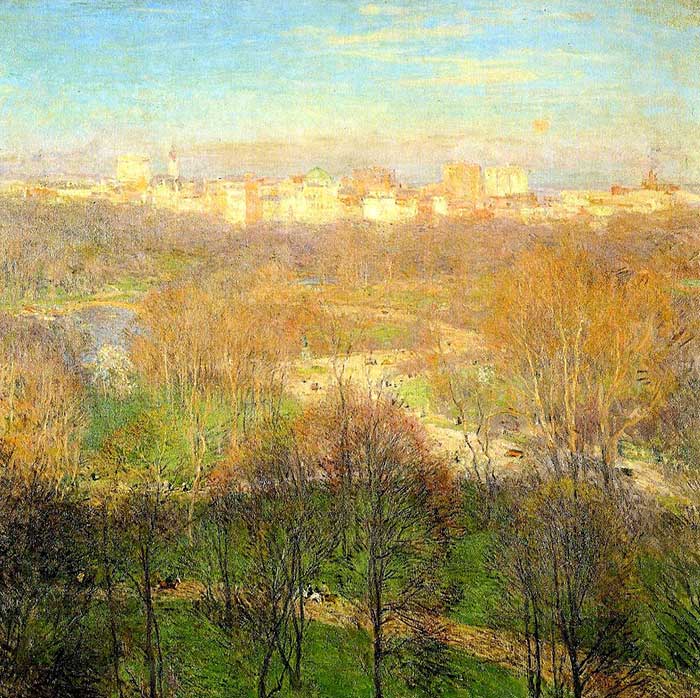
Willart Metcalf, Early Leap Afternoon, Fundamental Park, 1911
Interval contrast: A contrast between long and curt intervals. In the painting below, notice the variation in the lengths of the intervals between the copse. The interval dissimilarity can be used to create a sense of rhythm in your artwork.
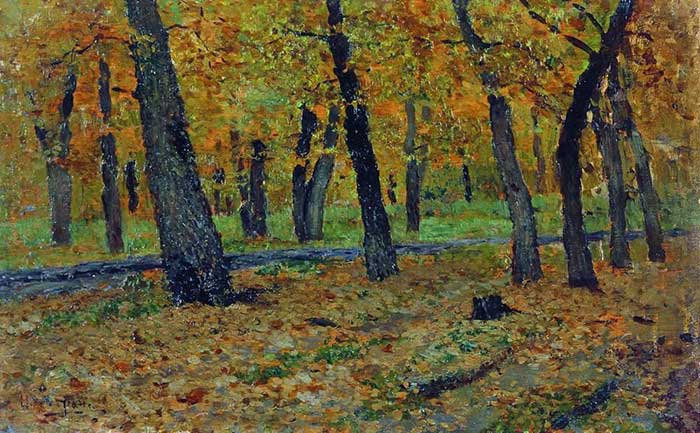
Isaac Levitan, Oak Grove, Autumn, 1880
Read more than about using dissimilarity.
Harmony And Unity
Harmony is a bit vague compared to some of the other principles. Generally speaking, it refers to how well all the visual elements piece of work together in a work of art. Elements which are in harmony should take some kind of logical progression or relationship. If at that place is an element which is not in harmony with the rest of an artwork, it should stick-out and exist jarring to wait at. Kind of like an off-note in a song.
Yous will ordinarily exist able to tell just from judgment if all the elements are in harmony. It will only look right. However, if the painting looks off, then information technology can exist difficult to tell if that is because at that place is no harmony between the elements or if there is some other issue.
When I remember of harmony, I think of the peaceful arrangements of color in Monet's series of water lilies.
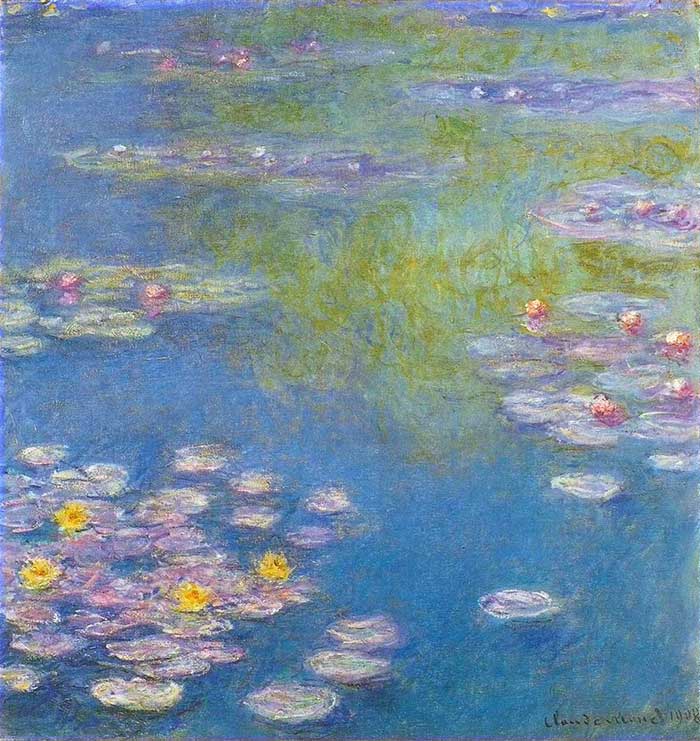
Claude Monet, Water Lilies, 1908
Unity refers to some kind of connection between all the visual elements in a work of art. Like harmony, this is a scrap of a vague term which is difficult to objectively use to analyze art. The painting below demonstrates a potent sense of unity through the use of a like hues used throughout the painting. Fifty-fifty though at that place is a strong dissimilarity between the light and nighttime areas, there is a sense of unity created through the employ of like hues (nighttime yellows, oranges and greens are used in the foreground and calorie-free yellows, oranges and greens are used in the groundwork).
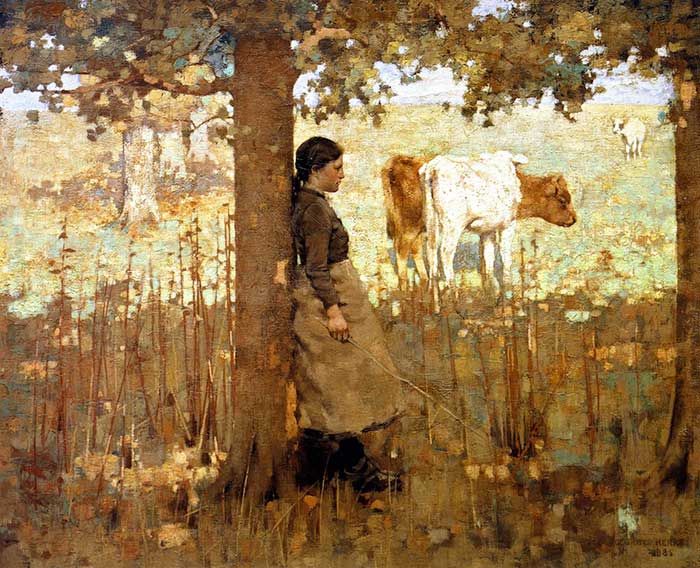
George Henry, Noon, 1885
Read more about using harmony.
Diversity
Variety refers to the use of differing qualities or instances of the visual elements. Diversity tin be used to break upwards monotonous or repetitive areas.
Beneath is a painting with lots of variation in color, shape and texture, yet non so much that it loses any sense of harmony.
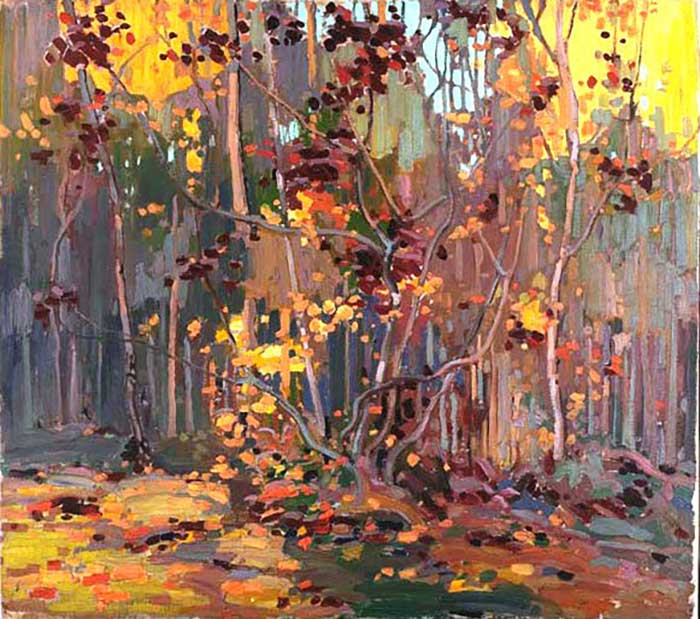
Tom Thomson, Maple Saplings, 1917
Below is a painting with comparatively less variance. The event is a much calmer painting.
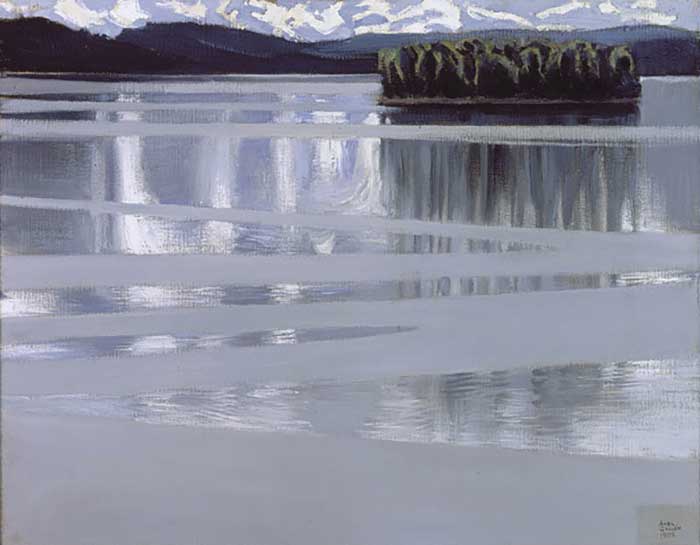
Lake Keitele, Akseli Gallen-Kallela, 1905
Movement
Your paints cannot physically move, simply you lot can adjust the paints in a manner which gives the illusion or proffer of movement.
Ane of the most constructive techniques for creating movement in your painting is to use bold and directional brushwork. By doing this, you can suggestively push your viewer around the painting equally you lot please. Yous could too suggest move through repetition or pattern.
Below are two examples of paintings which demonstrate a great sense of movement.

Joaquín Sorolla, Ocean And Rocks - Javea, 1900
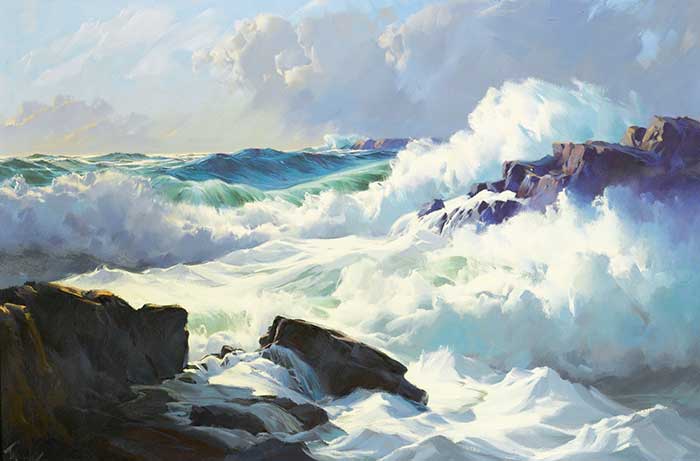
Frederick Judd Waugh, Breaking Surf
Also, I could not talk about using motion in fine art without some mention of Vincent van Gogh.
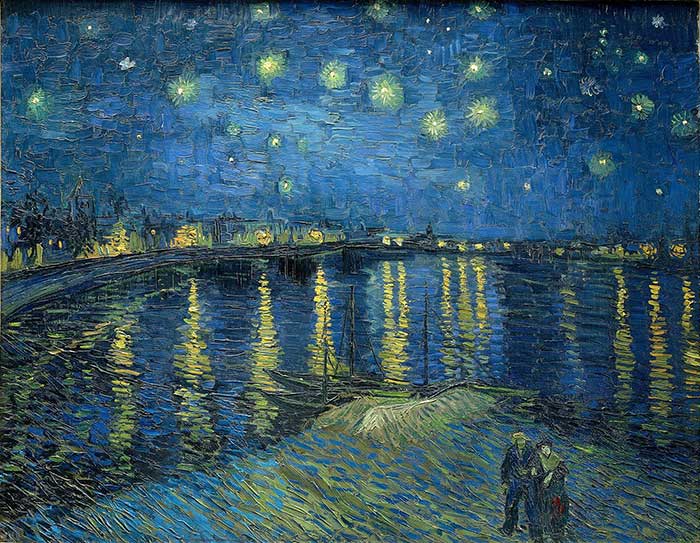
Vincent van Gogh, Starry Dark Over The Rhone, 1888
Read more than about movement in art here.
Proportion
Proportion concerns the human relationship between the sizes of different parts in an artwork. For case, the width compared to the length, the area of the heaven compared to the land or the expanse of foreground compared to the background.
Some proportions are considered to exist visually pleasing, such as the dominion of thirds and the golden ratio.
In the painting below past Giovanni Boldini, notice how the proportions of the female discipline's easily, face, feet and torso are all authentic. If Boldini painted the hand too big compared to the rest of the subject's body, there would be an effect of proportion.
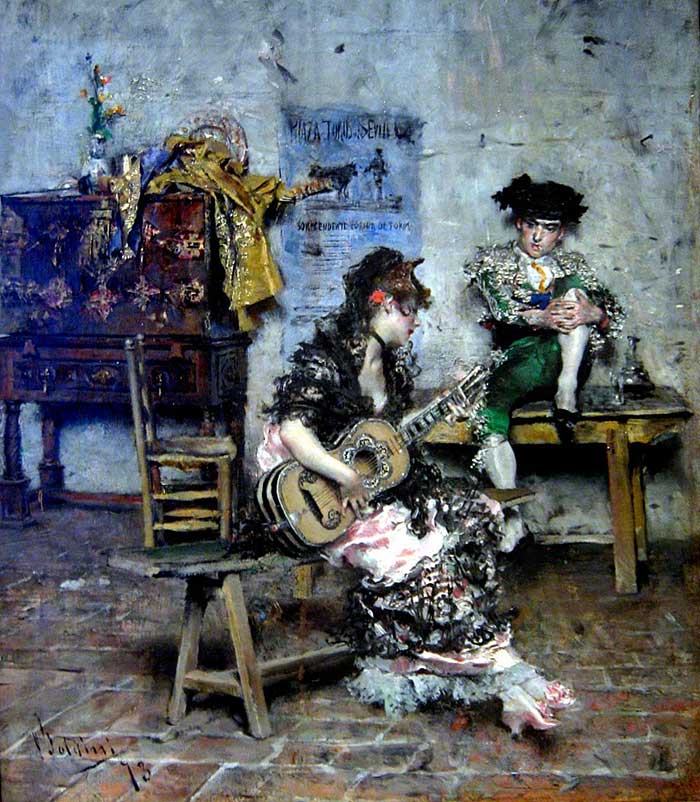
Giovanni Boldini, A Guitar Histrion, 1873
Calibration
Scale refers to the size of an object compared to the rest of the surround. For case, the size of a human being compared to the tree he is sitting under or the size of a mountain compared to the clouds. Scale is different to proportion in that scale refers to the size of an entire object whereas proportion refers to the relative size of parts of an object. For example, the scale of a man relative to the remainder of the painting may be correct, merely the proportion might be wrong because his hands are too large.

Summary Of The Principles Of Art
I hope this mail clarifies to yous what the principles of fine art are and how you tin can use them to help understand and communicate your thoughts about fine art.
Information technology is besides important to understand that a great painting does not take to tick all the boxes in terms of the principles of art. Most of the great paintings will merely demonstrate a few of the principles.
So exercise not think of the principles of art as a set of overarching rules which yous must comply with. They are just a fashion to aid us sympathize and communicate our thoughts most art.
The principles of art allow us to place some kind of objective reasoning backside why a great painting is great. This is important as it keeps united states from falling into a vague infinite where art is no longer able to be defined or critiqued (much similar what has happened with modernistic fine art).
(If you desire to learn more about the principles of art, you might be interested in my Painting Academy course.)
Source: https://drawpaintacademy.com/principles-of-art/
0 Response to "What Do You Call the Way Elements Are Arranged in a Work of Art?"
Postar um comentário